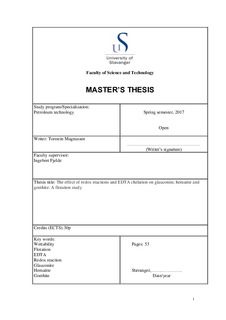| dc.contributor.advisor | Fjelde, Ingebret | |
| dc.contributor.author | Magnussen, Torstein | |
| dc.date.accessioned | 2017-10-26T08:08:15Z | |
| dc.date.available | 2017-10-26T08:08:15Z | |
| dc.date.issued | 2017-06-15 | |
| dc.identifier.uri | http://hdl.handle.net/11250/2462269 | |
| dc.description.abstract | Wettability is on of most important parameter of the reservoir, and to understand it is therefore of high importance (Donaldson & Alam, 2008). A sandstone reservoir can have a complexed minerology and each sandstone is unique in its complexity. It is therefore important to understand how the wetting of each mineral can be altered, so the best possible injection brine can be designed. The effect of chemical enhanced recovery can be tested on a core in the lab (Rajapaksha et al., 2014). For these test to represent the reservoir as accurate as possible the conditions must be the same. However the cores are often stored in contact with the atmosphere which is an oxidizing environment in contrast to the reduced state of the reservoir. By storing the core in contact with oxygen some iron containing minerals may be oxidized to ferric ions and create a ferric ion coating. These ferric ions can have a negative effect on the chemicals and thereby undermined the performance of the chemical flooding. A study by Rajapaksha et al (2014) proposes a new restoration method to reduces the ferric ions to ferrous ions and remove them by injecting sodium dithionite, EDTA and sodium bicarbonate. EDTA as used in the restoration method has been proposed as a chemical for enhanced recovery (Mahmoud, Attia, & Al-Hashim, 2017). To enhance the recovery, EDTA chelates cations from the injected brine and formation water. As this disturbs the rock-brine equilibrium, the rock releases cations that changes the surface to a more water-wet condition. The flotation method was used to teste how these chemicals and ferric ions affects the wettability of glauconite, hematite and goethite. First the effect of adding Fe3+ to the brine was tested on glauconite. The results showed more oil-wet particle if the total acid number of the oil was high enough. EDTA had surprisingly the same effect on glauconite and increased the concentration of oil-wet particles. Although it reduced the concentration of oil-wet particles for both hematite and goethite. The restoration chemicals had a reducing effect on the concentration of oil-wet particles for glauconite. However the effect of the restoration chemicals was significant in the hematite and goethite samples which changed from 100w% oil-wet in a Fw to under 10w% oil-wet in the restoration brine.
More tests can be done to further understand why EDTA increased the concentration of oil-wet particles. The EDTA concentration can be increased and the effect of pH can be further tested in a more alkaline solution. | nb_NO |
| dc.language.iso | eng | nb_NO |
| dc.publisher | University of Stavanger, Norway | nb_NO |
| dc.relation.ispartofseries | Masteroppgave/UIS-TN-IPT/2017; | |
| dc.subject | petroleumsteknologi | nb_NO |
| dc.subject | petroleum engineering | nb_NO |
| dc.subject | EDTA | nb_NO |
| dc.subject | Goethite | nb_NO |
| dc.subject | wettability | nb_NO |
| dc.subject | flotation | nb_NO |
| dc.subject | redox reaction | nb_NO |
| dc.subject | glauconite | nb_NO |
| dc.subject | hematite | nb_NO |
| dc.title | The effect of redox reactions and EDTA chelation on glauconite, hematite and goethite: A flotation study | nb_NO |
| dc.type | Master thesis | nb_NO |
| dc.description.version | submittedVersion | nb_NO |
| dc.subject.nsi | VDP::Teknologi: 500::Berg‑ og petroleumsfag: 510::Petroleumsteknologi: 512 | nb_NO |
